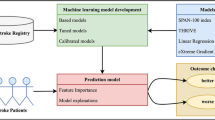Abstract
Cerebral stroke is a leading cause of physical disability and death in the world. The severity of a stroke is assessed by a neurological examination using a scale known as the NIH stroke scale (NIHSS). As a measure of stroke severity, the NIHSS score is widely adopted and has been found to also be useful in outcome prediction, rehabilitation planning and treatment planning. In many applications, such as in patient triage in under–resourced primary health care centres and in automated clinical decision support tools, it would be valuable to obtain the severity of stroke with minimal human intervention using simple parameters like age, past conditions and blood investigations. In this paper we propose a new model for predicting NIHSS scores which, to our knowledge, is the first statistical model for stroke severity. Our multi–view learning approach can handle data from heterogeneous sources with mixed data distributions (binary, categorical and numerical) and is robust against missing values – strengths that many other modeling techniques lack. In our experiments we achieve better predictive accuracy than other commonly used methods.
This work was supported by an Open Innovation Grant from Xerox Research Centre India.
Access this chapter
Tax calculation will be finalised at checkout
Purchases are for personal use only
Similar content being viewed by others
References
Adams, H., Davis, P., Leira, E., Chang, K.C., Bendixen, B., Clarke, W., Woolson, R., Hansen, M.: Baseline NIH stroke scale score strongly predicts outcome after stroke: a report of the trial of Org 10172 in acute stroke treatment (TOAST). Neurology 53(1), 126 (1999)
Archambeau, C., Delannay, N., Verleysen, M.: Robust probabilistic projections. In: Proceedings of the 23rd International Conference on Machine Learning, ICML 2006, pp. 33–40. ACM (2006)
Baird, A.E., Dambrosia, J., Janket, S.J., et al.: A three-item scale for the early prediction of stroke recovery. Lancet 357(9274), 2095–2099 (2001)
Caro, J.J., Huybrechts, K.F., Kelley, H.E., for the Stroke Economic Analysis Group: Predicting treatment costs after acute ischemic stroke on the basis of patient characteristics at presentation and early dysfunction. Stroke 32(1), 100–106 (2001)
Clark, W.M., Wissman, S., Albers, G.W., et al.: Recombinant tissue-type plasminogen activator (alteplase) for ischemic stroke 3 to 5 hours after symptom onset: the atlantis study: a randomized controlled trial. JAMA 282(21), 2019–2026 (1999)
DeGraba, T.J., Hallenbeck, J.M., Pettigrew, K.D., Dutka, A.J., Kelly, B.J.: Progression in acute stroke: value of the initial NIH stroke scale score on patient stratification in future trials. Stroke 30(6), 1208–1212 (1999)
Eissa, A., Krass, I., Bajorek, B.: Optimizing the management of acute ischaemic stroke: a review of the utilization of intravenous recombinant tissue plasminogen activator (tPA). J. Clin. Pharm. Ther. 37(6), 620–629 (2012)
Furlan, A., Higashida, R., Wechsler, L., et al.: Intra-arterial prourokinase for acute ischemic stroke: the proact ii study: a randomized controlled trial. JAMA 282(21), 2003–2011 (1999)
Hardoon, D., Szedmak, S., Shawe-Taylor, J.: Canonical correlation analysis: an overview with application to learning methods. Neural Comput. 16(12), 2639–2664 (2004)
Klami, A., Bouchard, G., Tripathi, A.: Group-sparse embeddings in collective matrix factorization. In: International Conference on Learning Representations (2014)
Klami, A., Virtanen, S., Kaski, S.: Bayesian canonical correlation analysis. J. Mach. Learn. Res. 14(1), 965–1003 (2013)
Goldstein, L.B., Bertels, C., Davis, J.N.: Interrater reliability of the NIH stroke scale. Arch. Neurol. 46, 660–662 (1989)
Lyden, P., Lu, M., Jackson, C., Marler, J., Kothari, R., Brott, T., Zivin, J.: Underlying structure of the national institutes of health stroke scale: results of a factor analysis. Stroke 30(11), 2347–2354 (1999)
NIH: Stroke scale. http://www.ninds.nih.gov/doctors/NIH_Stroke_Scale.pdf
World Health Organization: The world health report 2000 health systems: improving performance. http://www.who.int/cardiovascular_diseases/en/cvd_atlas_15_burden_stroke.pdf
Rocco, A., Pasquini, M., Cecconi, E., Sirimarco, G., Ricciardi, M.C., Vicenzini, E., Altieri, M., Di Piero, V., Lenzi, G.L.: Monitoring after the acute stage of stroke: a prospective study. Stroke 38(4), 1225–1228 (2007)
Saposnik, G., Guzik, A.K., Reeves, M., Ovbiagele, B., Johnston, S.C.: Stroke prognostication using age and NIH stroke scale: SPAN-100. Neurology 80(1), 21–28 (2013)
Schlegel, D., Kolb, S.J., Luciano, J.M., Tovar, J.M., Cucchiara, B.L., Liebeskind, D.S., Kasner, S.E.: Utility of the NIH stroke scale as a predictor of hospital disposition. Stroke 34(1), 134–137 (2003)
Tripathi, A., Klami, A., Kaski, S.: Simple integrative preprocessing preserves what is shared in data sources. BMC Bioinform. 9(1), 111 (2008)
Virtanen, S., Jia, Y., Klami, A., Darrell, T.: Factorized multi-modal topic model. In: Proceedings of the Twenty-Eighth Conference Annual Conference on Uncertainty in Artificial Intelligence (UAI 2012), pp. 843–851. AUAI Press (2012)
Acknowledgment
We thank Abhishek Tripathi who helped us with our experiments while he was at Xerox Research Centre India.
Author information
Authors and Affiliations
Corresponding author
Editor information
Editors and Affiliations
Rights and permissions
Copyright information
© 2016 Springer International Publishing Switzerland
About this paper
Cite this paper
Rajan, V., Bhattacharya, S., Shetty, R., Sitaram, A., Vivek, G. (2016). Clinical Decision Support for Stroke Using Multi–view Learning Based Models for NIHSS Scores. In: Cao, H., Li, J., Wang, R. (eds) Trends and Applications in Knowledge Discovery and Data Mining. PAKDD 2016. Lecture Notes in Computer Science(), vol 9794. Springer, Cham. https://doi.org/10.1007/978-3-319-42996-0_16
Download citation
DOI: https://doi.org/10.1007/978-3-319-42996-0_16
Published:
Publisher Name: Springer, Cham
Print ISBN: 978-3-319-42995-3
Online ISBN: 978-3-319-42996-0
eBook Packages: Computer ScienceComputer Science (R0)




